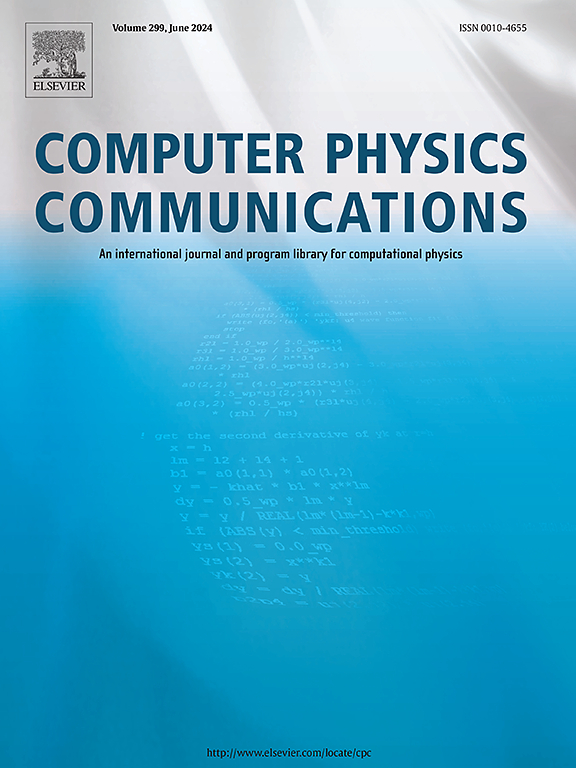Multiple spatio-temporal attention network: A deep convolutional network for spatio-temporal evolution prediction of flow fields
IF 3.4
2区 物理与天体物理
Q1 COMPUTER SCIENCE, INTERDISCIPLINARY APPLICATIONS
引用次数: 0
Abstract
The recent rapid development of machine learning has promoted its application in turbulence research. This paper presents a Multiple Spatio-Temporal Attention (MSTA) Network to predict the spatio-temporal evolution of multi-variable, multi-timestep turbulent flow fields. The model adopts a complete convolutional architecture instead of a recurrent structure typical of traditional time series models. Nonetheless, the model shows the ability to capture the temporal features of turbulence and form complex nonlinear relationships, thereby predicting the spatio-temporal evolution of turbulent flow fields both accurately and quickly. To improve the model’s prediction accuracy, we propose a novel channel attention mechanism, called Multiple Fusion Attention (MFA), which is designed to capture and fuse channel features at different positions more effectively. Additionally, a Spatial Transform Gradient Sharpening (STGS) method is proposed to constrain the spatial gradient in non-uniform curvilinear grids accurately. Based on the direct numerical simulations (DNS) results of a Mach 6, 34° compression ramp flow, two datasets of different sizes are established and related experiments are designed to validate the effectiveness of the proposed MSTA Network. The experimental comparison and analysis demonstrated the best performance in terms of accuracy and efficiency in the present comparison with other machine-learning models. Besides, a series of experiments considering different sample numbers, dataset sizes, prediction lengths, etc., also confirmed the robustness in various application scenarios. Finally, an extended experiment of the model was conducted on the HyTRV dataset from AeroFlowData under flow conditions of Mach 6 and 0° angle of attack, further demonstrating the model’s universality in diverse conditions.
多时空注意网络:一种用于流场时空演化预测的深度卷积网络
近年来机器学习的快速发展促进了机器学习在湍流研究中的应用。本文提出了一个多时空注意网络来预测多变量、多时间步长湍流流场的时空演变。该模型采用完全卷积结构,而不是传统时间序列模型的循环结构。尽管如此,该模型显示出捕捉湍流的时间特征并形成复杂非线性关系的能力,从而准确而快速地预测湍流流场的时空演变。为了提高模型的预测精度,我们提出了一种新的信道注意机制,称为多重融合注意(Multiple Fusion attention, MFA),该机制旨在更有效地捕获和融合不同位置的信道特征。此外,提出了一种空间变换梯度锐化(STGS)方法来精确约束非均匀曲线网格中的空间梯度。基于6马赫34°压缩斜坡流的直接数值模拟(DNS)结果,建立了两个不同规模的数据集,并设计了相关实验来验证所提出的MSTA网络的有效性。实验比较和分析表明,在目前与其他机器学习模型的比较中,该模型在准确性和效率方面表现最佳。此外,考虑不同样本数、数据集大小、预测长度等因素的一系列实验也证实了该算法在各种应用场景下的鲁棒性。最后,在AeroFlowData的HyTRV数据集上,对该模型进行了6马赫、0°攻角流动条件下的扩展实验,进一步验证了该模型在不同条件下的通用性。
本文章由计算机程序翻译,如有差异,请以英文原文为准。
求助全文
约1分钟内获得全文
求助全文
来源期刊

Computer Physics Communications
物理-计算机:跨学科应用
CiteScore
12.10
自引率
3.20%
发文量
287
审稿时长
5.3 months
期刊介绍:
The focus of CPC is on contemporary computational methods and techniques and their implementation, the effectiveness of which will normally be evidenced by the author(s) within the context of a substantive problem in physics. Within this setting CPC publishes two types of paper.
Computer Programs in Physics (CPiP)
These papers describe significant computer programs to be archived in the CPC Program Library which is held in the Mendeley Data repository. The submitted software must be covered by an approved open source licence. Papers and associated computer programs that address a problem of contemporary interest in physics that cannot be solved by current software are particularly encouraged.
Computational Physics Papers (CP)
These are research papers in, but are not limited to, the following themes across computational physics and related disciplines.
mathematical and numerical methods and algorithms;
computational models including those associated with the design, control and analysis of experiments; and
algebraic computation.
Each will normally include software implementation and performance details. The software implementation should, ideally, be available via GitHub, Zenodo or an institutional repository.In addition, research papers on the impact of advanced computer architecture and special purpose computers on computing in the physical sciences and software topics related to, and of importance in, the physical sciences may be considered.
 求助内容:
求助内容: 应助结果提醒方式:
应助结果提醒方式:


